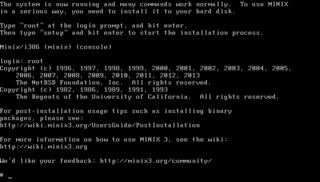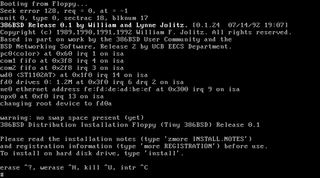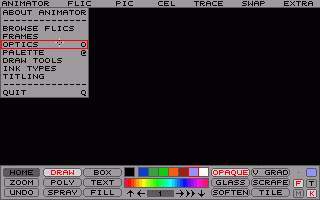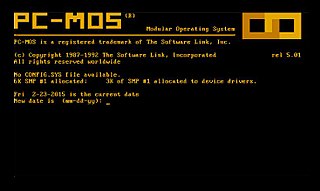Related Research Articles

MINIX is a Unix-like operating system based on a microkernel architecture. Since version 2.0, it has been Portable Operating System Interface (POSIX) compliant.

386BSD is a discontinued Unix operating system based on the Berkeley Software Distribution (BSD). It was released in 1992 and ran on PC-compatible computer systems based on the 32-bit Intel 80386 microprocessor. 386BSD innovations included role-based security, ring buffers, self-ordered configuration and modular kernel design.
A terminate-and-stay-resident program is a computer program running under DOS that uses a system call to return control to DOS as though it has finished, but remains in computer memory so it can be reactivated later. This technique partially overcame DOS's limitation of executing only one program, or task, at a time. TSRs are used only in DOS, not in Windows.
In computing, the DOS Protected Mode Interface (DPMI) is a specification introduced in 1989 which allows a DOS program to run in protected mode, giving access to many features of the new PC processors of the time not available in real mode. It was initially developed by Microsoft for Windows 3.0, although Microsoft later turned control of the specification over to an industry committee with open membership. Almost all modern DOS extenders are based on DPMI and allow DOS programs to address all memory available in the PC and to run in protected mode.

In DOS memory management, expanded memory is a system of bank switching that provided additional memory to DOS programs beyond the limit of conventional memory (640 KiB).

Autodesk Animator is a 2D computer animation and painting program published in 1989 for MS-DOS. It was considered groundbreaking when initially released.

DOS Navigator (DN) is an orthodox file manager for DOS, OS/2, and Windows.

UPX is a free and open source executable packer supporting a number of file formats from different operating systems.

Watcom C/C++ is an integrated development environment (IDE) product from Watcom International Corporation for the C, C++, and Fortran programming languages. Watcom C/C++ was a commercial product until it was discontinued, then released under the Sybase Open Watcom Public License as Open Watcom C/C++. It features tools for developing and debugging code for DOS, OS/2, Windows, Linux operating systems, which are based upon x86, IA-32, x86-64 compatible processors.

PC-MOS/386 is a multi-user, multitasking computer operating system produced by The Software Link (TSL), announced at COMDEX in November 1986 for February 1987 release. PC-MOS/386, a successor to PC-MOS, can run many MS-DOS programs on the host machine or a terminal connected to it. Unlike MS-DOS, PC-MOS/386 is optimized for the Intel 80386 processor; however early versions will run on any x86 computer. PC-MOS/386 used to be proprietary, but it was released as open-source software in 2017.

File Manager is a file manager program bundled with releases of OS/2 and Microsoft Windows between 1988 and 1999 and available from 6 April 2018 as an optional download for all modern releases of Windows, including Windows 10.

The Embeddable Linux Kernel Subset (ELKS), formerly known as Linux-8086, is a Linux-like operating system kernel. It is a subset of the Linux kernel, intended for 16-bit computers with limited processor and memory resources such as machines powered by Intel 8086 and compatible microprocessors not supported by 32-bit Linux.
Chez Scheme is a programming language, a dialect and implementation of the language Scheme which is a type of Lisp. It uses an incremental native-code compiler to produce native binary files for the x86, PowerPC, and SPARC processor architectures. It has supported the R6RS standard since version 7.9.1. It is free and open-source software released under an Apache License, version 2.0. It was first released in 1985, by R. Kent Dybvig, originally licensed as proprietary software, and then released as open-source software on GitHub on 2016-05-13 with version 9.4.

Homebrew is a free and open-source software package management system that simplifies the installation of software on Apple's operating system, macOS, as well as Linux. The name is intended to suggest the idea of building software on the Mac depending on the user's taste. Originally written by Max Howell, the package manager has gained popularity in the Ruby on Rails community and earned praise for its extensibility. Homebrew has been recommended for its ease of use as well as its integration into the command-line interface. Homebrew is a non-profit project member of the Software Freedom Conservancy, and is run entirely by unpaid volunteers.
In computing, diskcopy is a command used on a number of operating systems for copying the complete contents of a diskette to another diskette.
Google Authenticator is a software-based authenticator by Google that implements two-step verification services using the Time-based One-time Password Algorithm and HMAC-based One-time Password algorithm, for authenticating users of software applications.

The Windows Package Manager is a free and open-source package manager designed by Microsoft for Windows 10 and Windows 11. It consists of a command-line utility and a set of services for installing applications. Independent software vendors can use it as a distribution channel for their software packages.

GPUOpen is a middleware software suite originally developed by AMD's Radeon Technologies Group that offers advanced visual effects for computer games. It was released in 2016. GPUOpen serves as an alternative to, and a direct competitor of Nvidia GameWorks. GPUOpen is similar to GameWorks in that it encompasses several different graphics technologies as its main components that were previously independent and separate from one another. However, GPUOpen is entirely open source software, unlike GameWorks which is proprietary and closed.
ROCm is an Advanced Micro Devices (AMD) software stack for graphics processing unit (GPU) programming. ROCm spans several domains: general-purpose computing on graphics processing units (GPGPU), high performance computing (HPC), heterogeneous computing. It offers several programming models: HIP, OpenMP/Message Passing Interface (MPI), OpenCL.
Microsoft, a technology company historically known for its opposition to the open source software paradigm, turned to embrace the approach in the 2010s. From the 1970s through 2000s under CEOs Bill Gates and Steve Ballmer, Microsoft viewed the community creation and sharing of communal code, later to be known as free and open source software, as a threat to its business, and both executives spoke negatively against it. In the 2010s, as the industry turned towards cloud, embedded, and mobile computing—technologies powered by open source advances—CEO Satya Nadella led Microsoft towards open source adoption although Microsoft's traditional Windows business continued to grow throughout this period generating revenues of 26.8 billion in the third quarter of 2018, while Microsoft's Azure cloud revenues nearly doubled.
References
- ↑ "Qualitas 386MAX 6.x". WinWorld. Retrieved 2022-06-14.
- ↑ Jim Hall (2022-07-01). "The 386MAX source code has been released". The FreeDOS Project News. Retrieved 2023-02-17.
- ↑ "Sudley Place Software". Archived from the original on 2012-05-16. Retrieved 2011-12-16.
{{cite web}}: CS1 maint: bot: original URL status unknown (link)